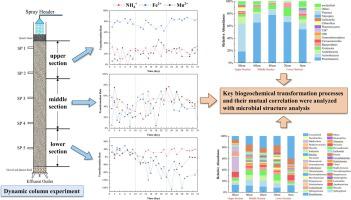Journal of Hydrology ( IF 5.9 ) Pub Date : 2021-10-30 , DOI: 10.1016/j.jhydrol.2021.127120 Rui Zuo 1, 2 , Minghao Pan 1, 2 , Jian Li 1, 2 , Li Meng 3 , Jie Yang 1, 2 , Yuanzheng Zhai 1, 2 , Zhenkun Xue 1, 2 , Jiawei Liu 1, 2 , Jian Shi 1, 2 , Yanguo Teng 1, 2

|
A dynamic column experiment using aquifer medium collected from a riverbank filtration (RBF) site in Northeast China was conducted to investigate the biogeochemical transformation processes of iron (Fe2+), manganese (Mn2+), ammonium (NH4+) and their interaction under coexisting conditions in real groundwater. Water parameters such as contaminant concentrations, pH and dissolved oxygen (DO) were determined while microbial analysis for the aquifer medium was performed through 16S rRNA sequencing. The results revealed that biochemical oxidation, reductive dissolution, adsorption were among the critical biogeochemical processes involved in the transformation of Fe2+, Mn2+ and NH4+, in which biological processes were the core process. The transformation rate of Fe2+, Mn2+ and NH4+ jointly revealed that the competition for DO existed throughout their co-oxidation process, and determined the spatial characteristics of their transformation processes to a certain extent. Fe2+ oxidation and nitrification primarily occurred in the upper oxidation zone (100 cm–70 cm), Mn2+ transformation and anaerobic ammonium oxidation (ANAMMOX) occurred mainly beneath the oxidation zone. The predominant area of microbial growth and metabolism was another key factor related to the spatial characteristics of biotransformation. The microbial analysis illustrated that Pseudomonas, Arthrobacter, Gallionella, Acinetobacter, Bacillus were among the dominant genera related to iron-oxidizing bacteria (IOB) and manganese-oxidizing bacteria (MnOB). The IOB-related genera were distributed mainly at 80 cm–60 cm with a relative abundance of 49%, MnOB-related genera were the most abundant (35%) bacteria at 60 cm–40 cm, and nitrifying bacteria (Nitrospira and Nitrosomonas) mainly existed in the upper part of the 100 cm–70 cm where nitrification occurred. The influence of microbial activity by changing chemical environment was manifested through the variation of transformation intensity during the experiment. The iron and manganese oxides generated by the bio-oxidation of Fe2+ and Mn2+ contributed significantly to the transformation of all three contaminants. The results may be valuable for understanding the evolution mechanism of groundwater when contaminated simultaneously with Fe2+, Mn2+ and NH4+.
中文翻译:

基于实验数据的地下水共存条件下铁、锰、铵的生物地球化学转化过程
【摘要】:以东北某河岸滤水(RBF)场地的含水层介质为动力柱,研究了铁(Fe 2+ )、锰(Mn 2+ )、铵(NH 4 + )和它们的生物地球化学转化过程。实际地下水共存条件下的相互作用。测定污染物浓度、pH 值和溶解氧 (DO) 等水参数,同时通过 16S rRNA 测序对含水层介质进行微生物分析。结果表明,生化氧化、还原溶解、吸附是参与Fe 2+、Mn 2+和NH 4转化的关键生物地球化学过程。+,其中生物过程是核心过程。Fe 2+、Mn 2+和NH 4 +的转化率共同揭示了它们在整个共氧化过程中都存在对DO的竞争,并在一定程度上决定了它们转化过程的空间特征。Fe 2+氧化和硝化主要发生在上部氧化带(100 cm-70 cm),Mn 2+转化和厌氧氨氧化(ANAMMOX)主要发生在氧化带下方。微生物生长和代谢的主要区域是与生物转化空间特征相关的另一个关键因素。微生物分析表明,假单胞菌属、节杆菌属、加氏菌属、不动杆菌属、芽孢杆菌属是与铁氧化细菌(IOB)和锰氧化细菌(MnOB)相关的优势属。IOB 相关属主要分布在 80 cm~60 cm,相对丰度为 49%,MnOB 相关属在 60 cm~40 cm 处最为丰富(35%),硝化细菌(Nitrospira和Nitrosomonas) 主要存在于发生硝化作用的 100 cm-70 cm 的上部。化学环境变化对微生物活性的影响通过实验过程中转化强度的变化表现出来。Fe 2+和Mn 2+的生物氧化产生的铁和锰氧化物对所有三种污染物的转化都有显着贡献。研究结果对于理解同时被Fe 2+、Mn 2+和NH 4 +污染时地下水的演化机制具有重要意义。






























 京公网安备 11010802027423号
京公网安备 11010802027423号